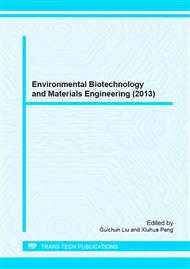[1]
Arrigo K. R. Marine microorganisms and global nutrient cycles[J]. Nature, 2005, 437(7057): 349-355.
DOI: 10.1038/nature04159
Google Scholar
[2]
Broda E. 2 kinds of lithotrophs missing in nature[J]. Zeitschrift Fur Allgemeine Mikrobiologie, 1977, 17(6): 491-493.
DOI: 10.1002/jobm.19770170611
Google Scholar
[3]
Mulder A., Vandegraaf A. A., Robertson L. A., et al. Anaerobic ammonium oxidation discovered in a denitrifying fluidized-bed reactor[J]. Fems Microbiology Ecology, 1995, 16(3): 177-183.
DOI: 10.1111/j.1574-6941.1995.tb00281.x
Google Scholar
[4]
Degraaf A. a. V., Debruijn P., Robertson L. A., et al. Autotrophic growth of anaerobic ammonium-oxidizing micro-organisms in a fluidized bed reactor[J]. Microbiology-Uk, 1996, 142: 2187-2196.
DOI: 10.1099/13500872-142-8-2187
Google Scholar
[5]
Strous M., Fuerst J. A., Kramer E. H. M., et al. Missing lithotroph identified as new planctomycete[J]. Nature, 1999, 400(6743): 446-449.
DOI: 10.1038/22749
Google Scholar
[6]
Schmid M., Twachtmann U., Klein M., et al. Molecular evidence for genus level diversity of bacteria capable of catalyzing anaerobic ammonium oxidation[J]. Systematic and Applied Microbiology, 2000, 23(1): 93-106.
DOI: 10.1016/s0723-2020(00)80050-8
Google Scholar
[7]
Egli K., Fanger U., Alvarez P. J. J., et al. Enrichment and characterization of an anammox bacterium from a rotating biological contactor treating ammonium-rich leachate[J]. Archives of Microbiology, 2001, 175(3): 198-207.
DOI: 10.1007/s002030100255
Google Scholar
[8]
Fujii T., Sugino H., Rouse J. D., et al. Characterization of the microbial community in an anaerobic ammonium-oxidizing biofilm cultured on a nonwoven biomass carrier[J]. Journal of Bioscience and Bioengineering, 2002, 94(5): 412-418.
DOI: 10.1016/s1389-1723(02)80218-3
Google Scholar
[9]
Pynaert K., Wyffels S., Sprengers R., et al. Oxygen-limited nitrogen removal in a lab-scale rotating biological contactor treating an ammonium-rich wastewater[J]. Water Science and Technology, 2002, 45(10): 357-363.
DOI: 10.2166/wst.2002.0369
Google Scholar
[10]
Schmid M., Walsh K., Webb R., et al. Candidatus scalindua brodae", sp nov., candidatus "scalindua wagneri, sp nov., two new species of anaerobic ammonium oxidizing bacteria[J]. Systematic and Applied Microbiology, 2003, 26(4): 529-538.
DOI: 10.1078/072320203770865837
Google Scholar
[11]
Sliekers A. O., Third K. A., Abma W., et al. Canon and anammox in a gas-lift reactor[J]. Fems Microbiology Letters, 2003, 218(2): 339-344.
DOI: 10.1016/s0378-1097(02)01177-1
Google Scholar
[12]
Third K. A., Paxman J., Schmid M., et al. Enrichment of anammox from activated sludge and its application in the canon process[J]. Microbial Ecology, 2005, 49(2): 236-244.
DOI: 10.1007/s00248-004-0186-4
Google Scholar
[13]
Kuypers M. M. M., Sliekers A. O., Lavik G., et al. Anaerobic ammonium oxidation by anammox bacteria in the black sea[J]. Nature, 2003, 422(6932): 608-611.
DOI: 10.1038/nature01472
Google Scholar
[14]
Rysgaard S., Glud R. N. Anaerobic n-2 production in arctic sea ice[J]. Limnology and Oceanography, 2004, 49(1): 86-94.
DOI: 10.4319/lo.2004.49.1.0086
Google Scholar
[15]
Kuypers M. M. M., Lavik G., Woebken D., et al. Massive nitrogen loss from the benguela upwelling system through anaerobic ammonium oxidation[J]. Proceedings of the National Academy of Sciences of the United States of America, 2005, 102(18): 6478-6483.
DOI: 10.1073/pnas.0502088102
Google Scholar
[16]
Kartal B., Rattray J., Van Niftrik L. A., et al. Candidatus anammoxoglobus propionicus, a new propionate oxidizing species of anaerobic ammonium oxidizing bacteria[J]. Systematic and Applied Microbiology, 2007, 30(1): 39-49.
DOI: 10.1016/j.syapm.2006.03.004
Google Scholar
[17]
Risgaard-Petersen N., Meyer R. L., Schmid M., et al. Anaerobic ammonium oxidation in an estuarine sediment[J]. Aquatic Microbial Ecology, 2004, 36(3): 293-304.
DOI: 10.3354/ame036293
Google Scholar
[18]
Vandegraaf A. A., Debruijn P., Robertson L. A., et al. Metabolic pathway of anaerobic ammonium oxidation on the basis of n-15 studies in a fluidized bed reactor[J]. Microbiology-Uk, 1997, 143: 2415-2421.
DOI: 10.1099/00221287-143-7-2415
Google Scholar
[19]
Sliekers A. O., Derwort N., Gomez J. L. C., et al. Completely autotrophic nitrogen removal over nitrite in one single reactor[J]. Water Research, 2002, 36(10): 2475-2482.
DOI: 10.1016/s0043-1354(01)00476-6
Google Scholar
[20]
Abma W. R., Driessen W., Haarhuis R., et al. Upgrading of sewage treatment plant by sustainable and cost-effective separate treatment of industrial wastewater[J]. Water Science and Technology, 2010, 61(7): 1715-1722.
DOI: 10.2166/wst.2010.977
Google Scholar
[21]
Strous M., Heijnen J. J., Kuenen J. G., et al. The sequencing batch reactor as a powerful tool for the study of slowly growing anaerobic ammonium-oxidizing microorganisms[J]. Applied Microbiology and Biotechnology, 1998, 50(5): 589-596.
DOI: 10.1007/s002530051340
Google Scholar
[22]
Administration S. E. P. Water and wastewater monitoring analysis method(4th ed)[S]. Beijing: China Environmental Science Press, (2002).
Google Scholar


